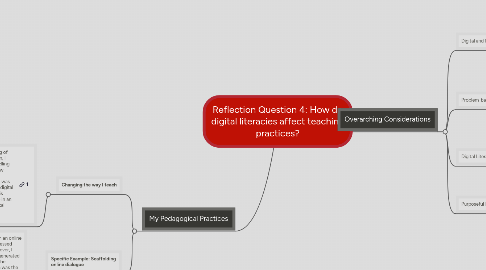
1. My Pedagogical Practices
1.1. Changing the way I teach
1.1.1. Before attending the Summer Institute, I already used a lot of technology in my teaching practice. I also took the 'Teacher as Facilitator' approach in my pedagogy and employed my own understanding of the inquiry-based model. However, after spending the week fully immersed in the Institute's inquiry-based model, which included strong scaffolded supports and an emphasis on reflection and revision, I have come to realize where I was falling short in my own practice. My new understanding of digital literacy will affect the way I teach in three primary ways: having students formulate their own compelling questions related to a topic of study with which they will use to drive their investigation (as opposed to providing them with the question); providing strong scaffolded support in terms of teaching new computer programs and digital literacy skills, and emphasizing the reflection and revision process in the classroom to encourage ownership and higher quality work. In the past, my approach to inquiry-based learning involved giving students a question to investigate and giving them options regarding the digital tools they could use to communicate. However, in retrospect, I don't believe this was the best approach as oftentimes, the students needed scaffolding to understand the communication affordances of the various digital tools. I thought that it was enough to direct the students to the digital tools available and have them figure out how to use the tools through discovery learning and peer-teaching. Not to say that this isn't a viable teaching strategy, however, I now realize that scaffolding is needed to help students understand the meaning associated with tools and their functions. In addition, often the end products the students created were not that great, but I didn't leave enough time in an activity for the students to reflect on their final products and then revise -- important skills in the digital age. The deeper analysis component, the de-mystifying element, the rigorous study of the digital tools was lacking in some of my lessons and I think these are important items that need to be included. Digital literacy, to me, is no longer just teaching students how to use digital tools, but closely analyzing and deconstructing their affordances and constraints as well.
1.2. Specific Example: Scaffolding online dialogue
1.2.1. Before starting my project with my partner, I knew there was a need to teach students how to positively and productively interact with others in an online environment. I had witnessed otherwise articulate and outgoing students retreat when it came to interacting in the virtual world. I had also witnessed otherwise withdrawn students troll, lurk and spam inappropriately in discussion forums, groups and chatrooms in our last research project. However, I was still unsure of the best way to teach students how to exist in the virtual world in a way that was non-inflammatory, furthered dialogue and generated knowledge. Implementing a scaffolded, problem-based learning model that taught students the language to use when interacting with others, the structure of how to engage in a forum discussion and the research skills to find and reference various reputable online sources in the discussion was the answer -- in addition to including a final reflection requiring students to discuss the affordances and constraints of online versus offline dialogues. I felt that by the end of our lesson plan, we had come up with a solid method to teaching this digital literacy skill. Where in the past, my approach to digital literacies emphasized student immersion in technology, I will now also be emphasizing scaffolding and reflective practices.
2. Overarching Considerations
2.1. Digital and Media Literacy Framework
2.1.1. When teaching digital literacies, it is important to consider this framework, which includes accessing and analyzing information, creating something in response to that information, reflecting on the impact of what was created and then sharing the product with a wider audience to incite change. As there is so much information on the Internet, it is imperative teachers guide students through the good practices involved in accessing and analyzing information. It is also critical that students understand how they create meaning with various tools and reflect on the impact of what they have created. These are elements involved in being good digital citizens.
2.2. Problem-based Inquiry Framework
2.2.1. This is another model that needs to be considered in the teaching process. It is similar to the Digital and Media Literacy Framework, however, it explicitly discusses the need for the creation of a compelling question to drive the inquiry process. This is an important feature in engaging students in a subject area as technology has created the participatory culture we now live in. Students now more than ever need to be active participants in the learning process in order to engage them and mimic their out-of-school realities and literacy practices. Furthermore, the PBI model creates a more democratic learning environment where teachers are facilitators and peers collaborate to generate knowledge -- not unlike the connectivist reality of the Internet. The transmission-based model is now ineffective.
2.3. Digital Literacy Curriculum Framework
2.3.1. This framework includes an important consideration when teaching digital literacy: thinking about the needs of the learner and his/her community context. Often teachers have their own priorities when it comes to teaching; however, to best engage and educate students, the student, the context and the community need to be considered. One student's reality and digital literacy needs may be entirely different from another student's reality and digital literacy needs in another area of the world.
2.4. Purposeful Integration of Technology
2.4.1. In implementing all this technology in the classroom, it is so important teachers do so with purpose. It is easy to dazzle students temporarily with cool websites and software, however, the meaning-making, analysis and reflection element need to be present.
